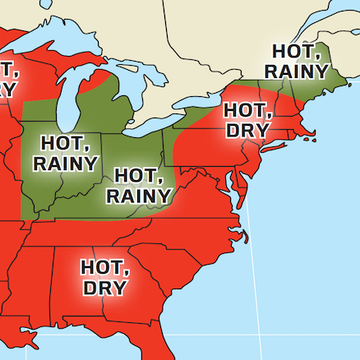- It takes the moon approximately 29.5 days to complete all eight lunar phases, meaning a full moon occurs roughly every month.
- The next full moon, the Strawberry Moon, will take place on June 11, 2025
- The name attributed to a full moon has more to do with what's happening in the environment during that lunar phase than the appearance of the moon. It's said to be the rarest full moon we'll see this year.
From picturesque beaches to the world's natural wonders, Earth has a lot to offer. However, those marvels can sometimes seem out of reach because of location, money or time. But there's one beauty that remains unrestricted — space. There's always something to see in the sky: constellations, meteor showers, comets and moon phases. The trick is knowing when to look.
Thankfully, The Old Farmer's Almanac released a list of full moon dates for 2025, complete with timestamps to view at peak illumination. Beyond information on full moon dates and times, the outlet also shared details on types of full moons. Some, you may be familiar with, such as a Corn Moon or Flower Moon, but others may be completely new. Anyone heard of a Sturgeon Moon?
We've got the full Farmer's Almanac breakdown below.
What's The Old Farmer's Almanac?
There's a good chance you've heard of The Old Farmer's Almanac, but you may not be familiar with its actual purpose. The resource began publication in 1792, releasing annual information on everything from long-range weather predictions, gardening tips, moon phases, recipes and more. This information was especially helpful for farmers and gardeners, but over time, others began to take note, due in large part to the almanac's reliability. The outlet claims to have an 80% accuracy rate. Because of this, it continues to be used as a helpful guide, even 233 years after its first publication.
How can the Farmer's Almanac predict the full moon?
The knowledge of moon phases has been around since B.C. times, with ancient Sumerians crafting a calendar around lunar phases. From this calendar, they learned that the moon experiences 12.37 complete cycles per year, with each cycle containing eight distinct phases: new moon, waxing crescent, first quarter, waxing gibbous, full moon, waning gibbous, third quarter and waning crescent.
This cycle takes approximately 29.5 days to complete. Because of the moon's consistency, it can be easily tracked, making predictions for future months straightforward.
The type of full moon is different. The names for these lunar peaks come from the culture of Indigenous Americans and other traditional sources. They used the name of the moon to track the seasons, referencing periods of 29.5 days by their lunar name as a means of keeping their bearings.
The moon's moniker is more indicative of the environment at the time than the moon's appearance. For instance, a Snow Moon occurs in February, not because the moon looks whiter than usual, but because snowfall is typically greatest during the month of February.
Full Moon Predictions 2025
While nearly half of this year's full moons have already occurred, there's still a chance to catch the remaining seven. Here's everything you need to know about the next full moon, including its date, best viewing time and what it means.
- January 13: Wolf Moon
(Peak Illumination- 5:27 p.m. ET)
The Wolf Moon became synonymous with January because of the habits of wildlife. Wolves, in particular, can be heard howling for food, claiming territory and gathering with packmates during this time of year. Other cultures refer to this moon as the Center Moon or Spirit Moon. - February 12: Snow Moon
(Peak Illumination- 8:53 a.m. ET)
February earned its name, Snow Moon, from Captain Jonathan Carver, who said, "more snow commonly falls during this month than any other in the winter.” The Snow Moon is also referred to as the Eagle Moon or Bear Moon. - March 14: Worm Moon
(Peak Illumination- 2:55 a.m. ET)
The arrival of spring sees earthworms wriggle to the top of warming soil that gets churned over for fresh flowers and vegetables. Because of this, March's moon is called the Worm Moon. It's also known as a Sugar Moon or Sore Eyes Moon in other cultures. - April 12: Pink Moon
(Peak Illumination- 8:22 p.m. ET)
April is known as the month of the Pink Moon because wild ground phlox, one of the first wildflowers to bloom in spring, covers the ground in a blanket of pink. In other cultures, April is marked by the Breaking Ice Moon or Frog Moon. - May 12: Flower Moon
(Peak Illumination- 12:56 p.m. ET)
Named after peak blooms seen throughout the month, the Algonquin and Ojibwe peoples assigned May the Flower Moon. Other groups, such as the Cree, Dakota and Lakota, associate May with the Budding Moon and Planting Moon. - June 11: Strawberry Moon
(Peak Illumination- 3:44 a.m. ET)
Inspired by the ripe strawberries that are ready to pick in June, the lunar phase earned the name Strawberry Moon. Additional names for the June full moon are Hot Moon and Birth Moon. It's said this will be the rarest full moon we see this year. For starters, it only happens every 18 years, according to Space.com. Another thing? It's the lowest a full moon has been in nearly 20 years— something scientists refer to as "major lunar standstill." - July 10: Buck Moon
(Peak Illumination- 4:37 p.m. ET)
Hunters will be unsurprised to know, July is when bucks, male deer, are in full antler growth. So the month's moon was named after them, Buck Moon. Raspberry Moon and Salmon Moon are also attributed to July. - August 9: Sturgeon Moon
(Peak Illumination- 3:55 a.m. ET)
Named after a migratory fish found in the Great Lakes and Lake Champlain, August is associated with the Sturgeon Moon. The fish used to be in much greater abundance than it is today. Ricing Moon and Black Cherries Moon are also known for August. - September 7: Corn Moon
(Peak Illumination- 2:09 p.m. ET)
As the dominant crop of the Midwest, September resonates with the Corn Moon, which begins to enter harvest in early fall. Other names for the September moon are the Harvest Moon and Autumn Moon. - October 6: Hunter's Moon
(Peak Illumination- 11:48 p.m. ET)
In preparation for winter, many animals stock up on food during the month of October, making it a bountiful period for hunting. That's why it has the name Hunter's Moon. The month has also been attributed to the Ice Moon and Migrating Moon. - November 5: Beaver Moon
(Peak Illumination- 8:19 a.m. ET)
Marked by the beaver's completed preparations for cold weather, November's moon was coined the Beaver Moon. Additional names for November's full moon are the Frost Moon and Whitefish Moon. - December 4: Cold Moon
(Peak Illumination- 6:14 p.m. ET)
Fairly self-explanatory, December's full moon is named the Cold Moon after the month's rapidly dropping temperatures. Long Night Moon and Mid-Winter Moon have also been used to describe this period of time.
Kate Franke (she/her) is an editorial assistant in the Hearst Lifestyle Group, covering for Woman's Day and Good Housekeeping. She loves all things lifestyle, home, and market related. Kate has a BAJMC in Magazine Media and BA in Writing from Drake University. She is a proud ASME alum whose work has appeared in Food Network Magazine, The Pioneer Woman Magazine, Better Homes & Gardens, Modern Farmhouse Style, Beautiful Kitchens & Baths, and more. Next to writing, Kate’s two favorite things are chai lattes and pumpkin bread!













